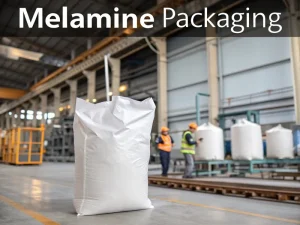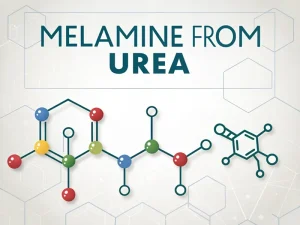
Melamine Packaging
Tech Blog Melamine packaging For manufacturers, inaccurate packaging not only fails to meet national standards but also increases labor costs and the risk of product


Melamine powder is a widely used organic compound, widely used in adhesives, plastics, coatings, and even food contact materials, playing a key role in countless industrial and consumer products. However, there is an often overlooked characteristic – the pH value of melamine, which refers to the acidity or alkalinity of melamine itself (solid or dissolved), and has a significant impact on polymerization reactions, solubility, and compatibility with other materials.
Let’s give the most direct answer first:
Melamine itself is a weak base.
When it dissolves in water, it forms a slightly alkaline solution with a pH of about 7. The pH value of a permeated melamine aqueous solution in the culture medium is usually between 7.5 and 9.5, depending on the concentration and temperature.
Therefore, if you want a quick answer: melamine is not acidic or neutral, but a chemically weak base.
To truly understand this, we must use the molecular structure of melamine (chemical formula: C₃H₆N₆).
The melamine molecule consists of two key components:
A six-membered ring consisting of alternating carbon atoms of three nitrogen atoms, and three triazine rings.
Three atoms (- NH2): connected to the three carbon atoms of the tricyclic ring.
Source of Flow: Orphans on Nitrogen Atoms for Electrons
According to Lewis acid-base theory, any substance that can provide lone pair electrons (lone pair electrons) is a base. There are six nitrogen atoms in the melamine molecule, and each nitrogen atom has a pair of lone pair electrons that do not participate in bonding.
Especially for nitrogen atoms located on the outer ring (- NH2), their lone pair electrons are relatively “active” and can accept protons (H ⁺) ionized by water molecules. Their common potential acid slightly increases the concentration of hydroxide ions (OH ⁻) in the purified solution, thus exhibiting alkalinity.
Why is melamine just a “weak” base, rather than a strong base like ammonia?
The answer lies in the third ring of that core.
The triazene ring is a strong electron-withdrawing group. The three nitrogen atoms inside the ring have the strongest electronegativity, and they will “pull” the lone pair electron density of the nitrogen atoms outside the ring towards the inside through the aggregation effect, causing these electrons to delocalize throughout the entire large π.
A simple analogy: Imagine the nitrogen atom above is preparing to donate its “money” (lone pair electrons) to protons in water. But its neighbor’s three rings are like a powerful magnet, attracting this “money” and greatly relieving the ability of nitrogen atoms to donate.
The dispersion of electron cloud density results in a significant decrease in the ability of nitrogen atoms in the upper layer to bind electrons, thus weakening their tendency to bind with protons and exhibiting properties much lower than those of simple amine compounds.
The pH value of melamine is not a theoretical property, as it directly affects the performance, safety, and cost-effectiveness of melamine-based products. The following are essential key application scenarios for pH control:
MF resin is the main application form of melamine, used for particleboard, laminated boards (such as Fumijia boards), and adhesives. PH control is crucial here:
The synthesis stage requires an alkaline environment (pH 8.5-10.0): Alkaline conditions can catalyze the reaction between melamine and formaldehyde, producing stable hydroxymethylmelamine (the structural unit of MF resin). If the pH drops below 8.0, the reaction rate will slow down, resulting in incomplete resin synthesis and insufficient strength of the final adhesive.
Neutralization of pH before curing: After synthesis is complete, a weak acid (such as formic acid) should be used to adjust the pH of the resin to 7.0-7.5. This can prevent the resin from “flash setting” (premature hardening) during storage and ensure uniform curing during heating (120-150 ℃) production.
Melamine and its derivatives (such as melamine sulfonate) are used to prevent mineral scaling (such as calcium carbonate) in boilers and industrial pipelines. The pH value determines its scale-inhibition effect:
The optimal pH range is acidic to neutral (6.0-7.5): At this pH, melamine derivatives can bind with calcium ions, preventing their scaling. If the pH rises above 8.0, calcium ions will react with OH ⁻ to form calcium hydroxide scale, causing melamine to lose its scale-inhibition effect.
The necessity of pH monitoring: Power plants using melamine-based scale inhibitors usually control the pH of boiler water at 6.5-7.0, reduce scaling by 30-40%, and extend pipeline service life by more than 5 years.
MCA is a non-toxic flame retardant used for plastics such as nylon and polyester. The pH value affects the compatibility with polymers:
Neutral pH (6.5-7.5) is required to avoid polymer degradation. If the pH value of MCA is<6.0 (over acidic) or>8.0 (over alkaline), it may react with polymer chains during processing (such as extrusion at 250 ℃), resulting in a 15-20% decrease in plastic tensile strength.
Quality control standard: Flame-retardant manufacturers are required to conduct batch-by-batch pH testing on MCA, and only batches with pH values within the range of 7.0 ± 0.5 can be used for high-performance plastics.
Melamine is used to manufacture drop-resistant tableware and food containers, and regulatory agencies such as the US FDA and EU EFSA require pH testing to ensure safety.
The finished product should have a neutral pH (6.8-7.2) to prevent melamine from dissolving into food. Acidic foods (such as tomatoes and citrus) have a pH value of<4.0. If they come into contact with alkaline melamine (pH>8.0), it may cause a small amount of melamine to dissolve; Neutralizing melamine to pH 7.0 during the production process can reduce the leaching amount to<0.1 mg/kg, far below the safety limit.
Required tools: Solid state pH meter (with flat conductive probe), analytical balance, distilled water.
Steps:
1. Weigh 5 g of melamine powder and mix it with 100 mL of distilled water (pH 7.0) in a beaker.
2. Gently stir at 25 ℃ for 30 minutes to form a saturated suspension (most melamine is insoluble).
3. Calibrate the solid-state pH meter with buffer solutions (pH 4.0, 7.0, 10.0).
4. Press the probe tightly onto the surface of melamine powder (or suspension), wait for 60 seconds until the reading stabilizes, and record the result.
Q1: Is melamine a strong base or a weak base?
A: Melamine is a weak base. Its alkalinity is very weak, far lower than ammonia water.
Q2: What is the pKa value of melamine?
A: Usually, when we discuss bases, we use the pKa value of their common potential acid to slow down. The pKa value of the co-potential acid of melamine is about 5.0. This means that its alkalinity is weaker than ammonia, with a pKa of 9.25.
Q3: Why is melamine difficult to dissolve in water?
A: There is a strong hydrogen bonding network between melamine molecules, and the intermolecular forces are the strongest. Baseline energy is required to break these hydrogen bonds and dissolve them in water, so its solubility in cold water is very low.
Q4: Will changing the melamine pH value affect the solubility of melamine?
A: I will. In acidic solutions, melamine reacts with acid as a base and is a highly soluble salt. Therefore, its solubility will significantly increase under acidic conditions.
In summary, melamine (melamine) dissolves as a weak base due to its molecular structure, and its aqueous solution typically has a pH value between 7.5 and 9.5.
The pH value of melamine is the fundamental characteristic that determines its performance in various industries, from resin synthesis to food safety, all of which are closely related to it. Although pure melamine is neutral, solvent, temperature, and chemical modification can all change its pH value, directly affecting key performance indicators such as resin strength, flame retardant compatibility, and leaching risk.

Tech Blog Melamine packaging For manufacturers, inaccurate packaging not only fails to meet national standards but also increases labor costs and the risk of product

Tech Blog How to Detect Melamine in Textiles? Melamine powder, a nitrogen-containing heterocyclic compound, is widely used in flame-retardant textiles and plastic products due to

Tech Blog melamine from urea Melamine is well-known for its wide range of applications, but its raw material for production is surprisingly urea. For manufacturers,

JINGJIANG MELAMINE POWDER
© JINJIANG MELAMINE